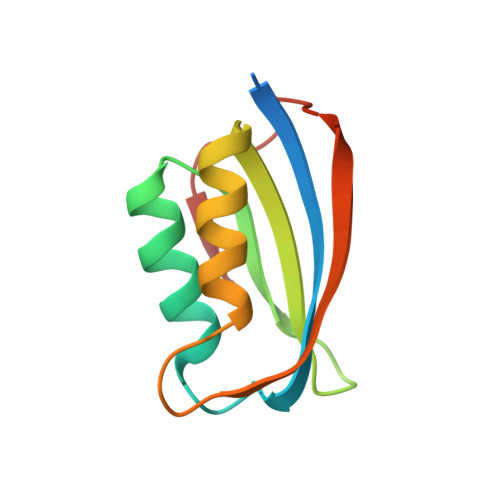Structure, Conformational Stability, and Enzymatic Properties of Acylphosphatase from the Hyperthermophile Sulfolobus Solfataricus.
Corazza, A., Rosano, C., Pagano, K., Alverdi, V., Esposito, G., Capanni, C., Bemporad, F., Plakoutsi, G., Stefani, M., Chiti, F., Zuccotti, S., Bolognesi, M., Viglino, P.(2006) Proteins 62: 64
- PubMed: 16287076
- DOI: https://doi.org/10.1002/prot.20703
- Primary Citation of Related Structures:
1Y9O, 2BJD, 2BJE - PubMed Abstract:
The structure of AcP from the hyperthermophilic archaeon Sulfolobus solfataricus has been determined by (1)H-NMR spectroscopy and X-ray crystallography. Solution and crystal structures (1.27 A resolution, R-factor 13.7%) were obtained on the full-length protein and on an N-truncated form lacking the first 12 residues, respectively. The overall Sso AcP fold, starting at residue 13, displays the same betaalphabetabetaalphabeta topology previously described for other members of the AcP family from mesophilic sources. The unstructured N-terminal tail may be crucial for the unusual aggregation mechanism of Sso AcP previously reported. Sso AcP catalytic activity is reduced at room temperature but rises at its working temperature to values comparable to those displayed by its mesophilic counterparts at 25-37 degrees C. Such a reduced activity can result from protein rigidity and from the active site stiffening due the presence of a salt bridge between the C-terminal carboxylate and the active site arginine. Sso AcP is characterized by a melting temperature, Tm, of 100.8 degrees C and an unfolding free energy, DeltaG(U-F)H2O, at 28 degrees C and 81 degrees C of 48.7 and 20.6 kJ mol(-1), respectively. The kinetic and structural data indicate that mesophilic and hyperthermophilic AcP's display similar enzymatic activities and conformational stabilities at their working conditions. Structural analysis of the factor responsible for Sso AcP thermostability with respect to mesophilic AcP's revealed the importance of a ion pair network stabilizing particularly the beta-sheet and the loop connecting the fourth and fifth strands, together with increased density packing, loop shortening and a higher alpha-helical propensity.
- Dipartimento di Scienze e Tecnologie Biomediche, Università di Udine, Udine, Italy.
Organizational Affiliation:



















